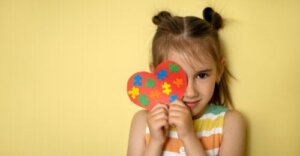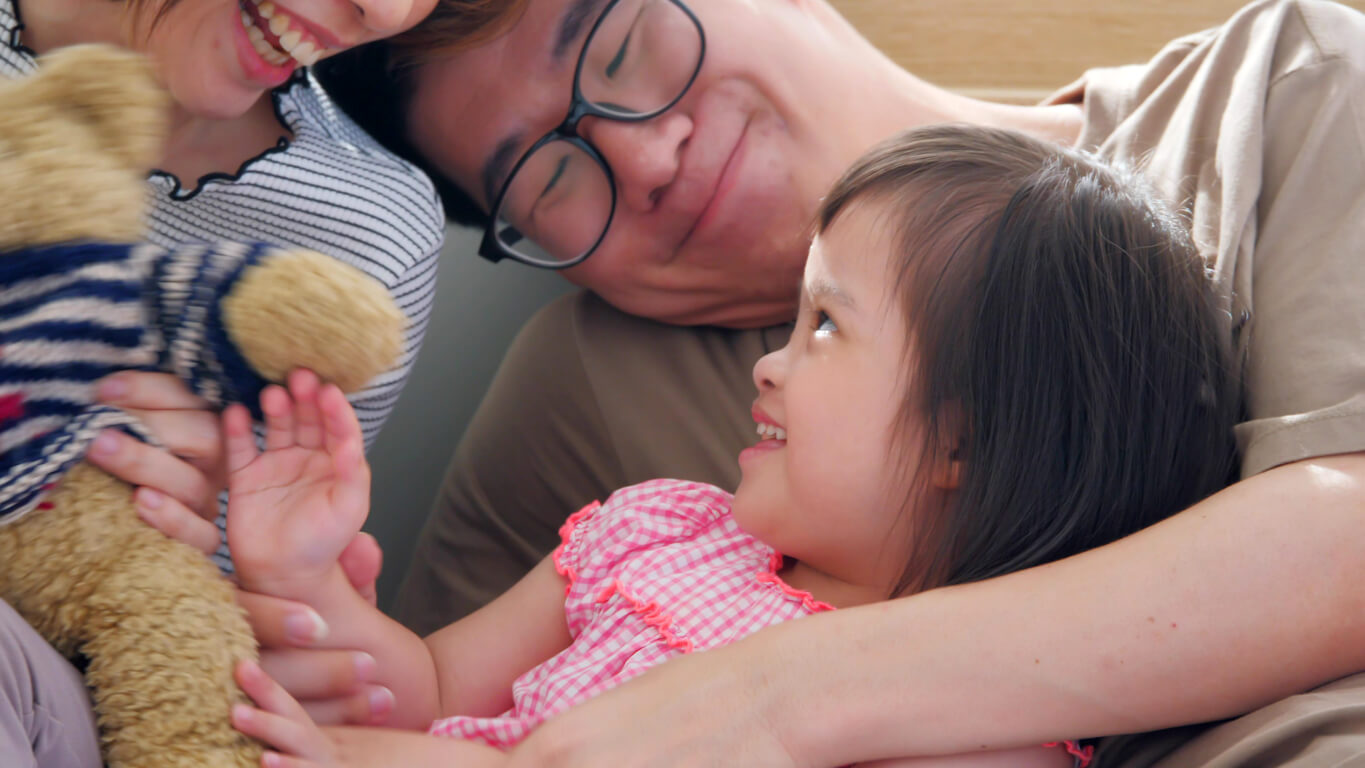7 Keys to Make a Child with Autism Happy

Every April 2nd, World Autism Awareness Day is celebrated, and this year, the chosen motto contains a powerful message that we should all internalize. “A happy journey through life” invites us to remember that people with this condition, as well as their families, have the potential and the right to enjoy a full existence. For this reason, today we want to share some keys to make a child with autism happy.
It’s estimated that at least one in 160 children has autism spectrum disorder (ASD). However, their qualities, their abilities, and their needs can be very different from one another. Our intent in this article isn’t to define the main clinical signs of this condition, but we will remind you that communication and behavior patterns are two of the most affected areas.
When the necessary supports are personalized and sufficient, children with ASD can thrive in a variety of areas and live happy, meaningful lives, regardless of how well they function. Therefore, we want to suggest some keys that can help increase their well-being. Don’t miss this important information!
How to make a child with autism happy
The following are some basic areas that should be covered to ensure the happiness of these children.
1. Obtain early diagnosis and care
Many view autism as a negative “label” that limits and stigmatizes a person. However, it’s important to understand the difference between a label and a diagnosis. . A proper diagnosis is the key to understanding what’s happening and proceeding appropriately.
Many families make a long pilgrimage through the offices of various specialists until they reach the diagnosis of ASD in their children. Even after receiving other wrong or incomplete diagnoses. And what’s even worse, hundreds of people with autism don’t identify what happens to them until adulthood.
This process not only leads to misunderstanding and confusion, but above all, it deprives children of receiving early attention capable of changing the course of their lives. Social skills training before school age and family education on autism are critical to making rapid and significant progress.
For this reason, the first thing a child with ASD needs is access to an early diagnosis and timely, personalized, and quality intervention.
2. Provide a safe environment
We all have mechanisms to self-regulate when anxiety or external stimuli overwhelm us. For example, we bite our nails or purse our lips.
But for children with autism, these self-regulatory behaviors can be conspicuous and worrying, such as head banging, skin scratching, or other self- injurious behaviors. However, the objective is the same as in the previous example.
Therefore, it’s important that the spaces in which these children primarily live are safe. Finding predictability and calm at home and at school greatly helps them feel good and reduce tantrums and other manifestations of their condition.

3. Promote communication to make children with autism happy
To make a child with autism happy, we have to teach them to communicate. It doesn’t matter if they can speak fluently, barely pronounce a few words, or not verbalize at all. What’s truly relevant is that they can express themselves and make requests through gestures, signs, communication devices, or any other resource.
Their close environment must invite them to interact frequently, ask their opinions, and listen to their needs. And for this, the intervention to improve communication must be a constant. This way, the minor will be able to get used to looking for others and practicing their communication skills, which will allow them to have important advances in their lives and greater well-being.
You may be interested: 3 Guidelines to Improve Communication in Children with ASD
Finally, although there’s a myth that people with autism withdraw voluntarily and out of conviction, we all want and need to be accepted and be part of our environment.
4. Promote their learning and the development of autonomy
A frequent mistake that the close environment of the child and society usually make is to overprotect children with autism.
Somehow, in the collective imagination, this condition is still considered a disease and not a manifestation of human diversity. Therefore, these children are considered incapable and totally dependent simply because they carry the diagnosis of ASD.
However, the best we can do for these little ones is to help them develop their potential because they all have it. They’ll surely need help, supervision, and practice, but each learning experience, each achievement, and each advance will be extremely rewarding.
So, both families and schools must emphasize learning skills for daily living: Being able to spread butter on bread or go to a store to buy a product without anyone’s help.
These small details increase self-esteem and the feeling of worth in people and give them valuable independence.
5. Accept them and understand them
One of the most important tasks to address in children with ASD is the recognition of their rights. And for that, governments and organizations must work actively on awareness, disclosure, and the promotion of empathy on the part of society towards these people.
People with autism often live life wearing a mask to try to accommodate social demands. It’s mistakenly thought that the goal is to eliminate or camouflage the symptoms of their condition when the real challenge is for everyone to be happy being who they are.
To achieve this goal, we must understand neurodiversity, understand how people with ASD function and see life.
Parents, relatives, classmates, and everyone in the environment must receive truthful information that allows them to understand the reality of these children and not force them to be who they aren’t. Rather, accept them and facilitate the conditions that allow them to feel good.

6. Strengthen self-esteem and confidence
Imagine growing up surrounded by people who stress to you all the time that you can’t do this or that, that you’ll never have a normal life, that you won’t be able to achieve your goals… This, without a doubt, is the antithesis of happiness.
Therefore, one of the greatest gifts we can offer our children with autism is confidence, encouragement, and the certainty that they can achieve their goals and that they can grow and move forward in their lives. This is the seed that will germinate their own self-confidence and that will allow them to display their qualities.
7. Help them understand their purpose in life
Lastly, and just like any other human being, these minors need to grow up with purpose. That is, to know that they’re useful and valuable, to feel that they belong and that they can contribute something to their environment.
We can achieve this goal in multiple ways and with small acts on a daily basis. For example, by putting aside their apparent limitations and by encouraging them to participate and to contribute what makes them unique.
Making a child with autism happy isn’t an unobtainable goal
As you can see, what a child with autism needs to be happy is very similar to what any other person requires: Love, acceptance, respect, and empathy. They’re also happy playing with their peers, watching movies with their parents, or going on a family outing. And, of course, they also bring large doses of happiness to those around them.
The challenge is to understand them and be able to accommodate them, instead of forcing them to accommodate us. Perhaps they need predictable routines, pictographic aids, or communication supports. But without a doubt, they’ll benefit from curricular adaptations and personalized interventions to achieve a better future projection.
Both individuals with ASD and their families have the right to lead a full and happy life. And for this, important and fair social work must be done, offering the support and resources that children and adults need.
Therefore, awareness, family training, financial aid, specialized schools, support groups, or access to quality interventions become a maxim to guarantee the well-being of all.
Every April 2nd, World Autism Awareness Day is celebrated, and this year, the chosen motto contains a powerful message that we should all internalize. “A happy journey through life” invites us to remember that people with this condition, as well as their families, have the potential and the right to enjoy a full existence. For this reason, today we want to share some keys to make a child with autism happy.
It’s estimated that at least one in 160 children has autism spectrum disorder (ASD). However, their qualities, their abilities, and their needs can be very different from one another. Our intent in this article isn’t to define the main clinical signs of this condition, but we will remind you that communication and behavior patterns are two of the most affected areas.
When the necessary supports are personalized and sufficient, children with ASD can thrive in a variety of areas and live happy, meaningful lives, regardless of how well they function. Therefore, we want to suggest some keys that can help increase their well-being. Don’t miss this important information!
How to make a child with autism happy
The following are some basic areas that should be covered to ensure the happiness of these children.
1. Obtain early diagnosis and care
Many view autism as a negative “label” that limits and stigmatizes a person. However, it’s important to understand the difference between a label and a diagnosis. . A proper diagnosis is the key to understanding what’s happening and proceeding appropriately.
Many families make a long pilgrimage through the offices of various specialists until they reach the diagnosis of ASD in their children. Even after receiving other wrong or incomplete diagnoses. And what’s even worse, hundreds of people with autism don’t identify what happens to them until adulthood.
This process not only leads to misunderstanding and confusion, but above all, it deprives children of receiving early attention capable of changing the course of their lives. Social skills training before school age and family education on autism are critical to making rapid and significant progress.
For this reason, the first thing a child with ASD needs is access to an early diagnosis and timely, personalized, and quality intervention.
2. Provide a safe environment
We all have mechanisms to self-regulate when anxiety or external stimuli overwhelm us. For example, we bite our nails or purse our lips.
But for children with autism, these self-regulatory behaviors can be conspicuous and worrying, such as head banging, skin scratching, or other self- injurious behaviors. However, the objective is the same as in the previous example.
Therefore, it’s important that the spaces in which these children primarily live are safe. Finding predictability and calm at home and at school greatly helps them feel good and reduce tantrums and other manifestations of their condition.

3. Promote communication to make children with autism happy
To make a child with autism happy, we have to teach them to communicate. It doesn’t matter if they can speak fluently, barely pronounce a few words, or not verbalize at all. What’s truly relevant is that they can express themselves and make requests through gestures, signs, communication devices, or any other resource.
Their close environment must invite them to interact frequently, ask their opinions, and listen to their needs. And for this, the intervention to improve communication must be a constant. This way, the minor will be able to get used to looking for others and practicing their communication skills, which will allow them to have important advances in their lives and greater well-being.
You may be interested: 3 Guidelines to Improve Communication in Children with ASD
Finally, although there’s a myth that people with autism withdraw voluntarily and out of conviction, we all want and need to be accepted and be part of our environment.
4. Promote their learning and the development of autonomy
A frequent mistake that the close environment of the child and society usually make is to overprotect children with autism.
Somehow, in the collective imagination, this condition is still considered a disease and not a manifestation of human diversity. Therefore, these children are considered incapable and totally dependent simply because they carry the diagnosis of ASD.
However, the best we can do for these little ones is to help them develop their potential because they all have it. They’ll surely need help, supervision, and practice, but each learning experience, each achievement, and each advance will be extremely rewarding.
So, both families and schools must emphasize learning skills for daily living: Being able to spread butter on bread or go to a store to buy a product without anyone’s help.
These small details increase self-esteem and the feeling of worth in people and give them valuable independence.
5. Accept them and understand them
One of the most important tasks to address in children with ASD is the recognition of their rights. And for that, governments and organizations must work actively on awareness, disclosure, and the promotion of empathy on the part of society towards these people.
People with autism often live life wearing a mask to try to accommodate social demands. It’s mistakenly thought that the goal is to eliminate or camouflage the symptoms of their condition when the real challenge is for everyone to be happy being who they are.
To achieve this goal, we must understand neurodiversity, understand how people with ASD function and see life.
Parents, relatives, classmates, and everyone in the environment must receive truthful information that allows them to understand the reality of these children and not force them to be who they aren’t. Rather, accept them and facilitate the conditions that allow them to feel good.

6. Strengthen self-esteem and confidence
Imagine growing up surrounded by people who stress to you all the time that you can’t do this or that, that you’ll never have a normal life, that you won’t be able to achieve your goals… This, without a doubt, is the antithesis of happiness.
Therefore, one of the greatest gifts we can offer our children with autism is confidence, encouragement, and the certainty that they can achieve their goals and that they can grow and move forward in their lives. This is the seed that will germinate their own self-confidence and that will allow them to display their qualities.
7. Help them understand their purpose in life
Lastly, and just like any other human being, these minors need to grow up with purpose. That is, to know that they’re useful and valuable, to feel that they belong and that they can contribute something to their environment.
We can achieve this goal in multiple ways and with small acts on a daily basis. For example, by putting aside their apparent limitations and by encouraging them to participate and to contribute what makes them unique.
Making a child with autism happy isn’t an unobtainable goal
As you can see, what a child with autism needs to be happy is very similar to what any other person requires: Love, acceptance, respect, and empathy. They’re also happy playing with their peers, watching movies with their parents, or going on a family outing. And, of course, they also bring large doses of happiness to those around them.
The challenge is to understand them and be able to accommodate them, instead of forcing them to accommodate us. Perhaps they need predictable routines, pictographic aids, or communication supports. But without a doubt, they’ll benefit from curricular adaptations and personalized interventions to achieve a better future projection.
Both individuals with ASD and their families have the right to lead a full and happy life. And for this, important and fair social work must be done, offering the support and resources that children and adults need.
Therefore, awareness, family training, financial aid, specialized schools, support groups, or access to quality interventions become a maxim to guarantee the well-being of all.
All cited sources were thoroughly reviewed by our team to ensure their quality, reliability, currency, and validity. The bibliography of this article was considered reliable and of academic or scientific accuracy.
- Miller, C. (2021, 2 agosto). ¿Por qué se suelen demorar los diagnósticos de autismo? Child Mind Institute. Disponible en: https://childmind.org/es/articulo/por-que-se-suelen-demorar-los-diagnosticos-de-autismo/
- Organización Mundial de la Salud. (2021, 1 junio). Trastornos del espectro autista. WHO. https://www.who.int/es/news-room/fact-sheets/detail/autism-spectrum-disorders
- Soke, G. N., Rosenberg, S. A., Hamman, R. F., Fingerlin, T., Robinson, C., Carpenter, L., … & DiGuiseppi, C. (2016). Brief report: prevalence of self-injurious behaviors among children with autism spectrum disorder—a population-based study. Journal of autism and developmental disorders, 46(11), 3607-3614.
This text is provided for informational purposes only and does not replace consultation with a professional. If in doubt, consult your specialist.








